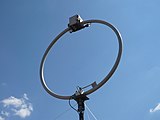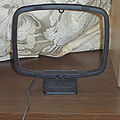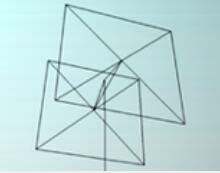Antenna Types – Loop Antenna
February 4, 2019
Antenna Types – Loop Antenna

Ferrite loopstick antenna from an AM broadcast radio, about 4 in (10 cm) long. The antenna is inductive and, in conjunction with a variable capacitor, forms the tuned circuit at the input stage of the receiver.

Loop antenna for transmitting at high frequencies, 2m diameter

Separate loop antenna for AM radio

A two-element quad antenna used by an amateur radio station
Loop antennas consist of a loop (or coil) of wire. Loop antennas interact directly with the magnetic field of the radio wave, rather than its electric field, making them relatively insensitive to electrical noise within about a quarter-wavelength of the antenna.There are essentially two broad categories of loop antennas: large loops (or full-wave loops) and small loops. Only one design, a “halo” antenna, that is usually called a loop does not fit into either the large or small loop categories.
Large loops
Full loops have the highest radiation resistance, and hence the highest efficiency of all antennas: Their radiation resistances are several hundreds of Ohms, whereas dipoles and monopoles are tens of Ohms, and small loops are a few ohms, or even fractions of an Ohm.
Large loops – Loops with perimeter of a full wavelength, two wavelengths, or any whole-number multiple of a full-wavelength, are naturally resonant and act somewhat similarly to the full-wave or multi-wave dipole. When it is necessary to distinguish them from small loops, they are called “full-wave” loops.
Quad – Although “quad” can refer to a single quadrilateral-shaped loop, the term usually refers to two or more loops stacked side by side; at first glance, quads resemble a box kite frame. One loop in the quad is connected to the feedline and functions as the driver for the antenna and is the main signal radiator, while the others are parasitic element that act as resonators, increasing the gain. Quad antennas function analogously to Yagi-Uda antennas made with loops, and are similarly used as a directional antennas on the HF bands for shortwave communication. They are sometimes preferred for longer wavelengths because (if square) they are half as wide as a Yagi.
Half-loop – A ground-mounted upper half of a full-wavelength loop antenna (not to be confused with a half-square array). The full loop is cut at two opposite points along its perimeter, and the lower half is omitted. It is shaped like the Greek letter Π or an upside-down capital letter U, and is the loop antenna analog of a ground-mounted monopole antenna. Like a vertical monopole, the missing lower half of the antenna is replaced by its ground-plane image. If shaped like a half of a square, a half-loop can operate either as a loop antenna or, on its first harmonic, as a dipole antenna whose ends have been bent over and grounded, depending on the form and location of the feed-point.
Inbetween
Halo antennas – Loops that are exactly one half-wavelength in perimeter – with a small gap cut in the loop – are called “halo antennas” and are intermediate in form and function between small and large loops. They are often described as a half-wavelength dipole that has been folded into a circle, rather than being a true loop antenna.
Small loops
The great disadvantage of any small antenna, including small loops, is a very small radiation resistance – typically much smaller than the loss resistance, making small loops very inefficient for transmitting. However, small loops are very effective receiving antennas, especially at low frequencies, where all feasible antennas are “small” compared to a wavelength.
Small loops – If the loop perimeter is smaller than a half-wavelength, the loop must be modified in some way to make it resonant, if resonance is necessary. Small loops are called “magnetic loops”, and if modified for resonance they are also called “tuned loops”. Their directionality and radiation efficiency is drastically different from full-wave loops. Small loops are widely used as compact direction finding antennas.
Ferrite (loopstick) – Loopstick antennas are omnidirectional around their axes, and are premier examples of small loop antennas. They are the magnetic analogue of the short dipole antenna. These are used as the receiving antenna in most consumer AM radios operating in the medium wave broadcast band (and lower frequencies). Wire is coiled around a ferrite core which greatly increases the coil’s inductance and its effective signal-capturing area. The radiation pattern is maximum at directions perpendicular to the ferrite rod. The null direction of ferrite core antennas are bi-directional and much sharper than the maximal directionality. This often makes the direction of the null more useful for locating a signal source than the direction of the strongest signal. The null direction of small loops can also be exploited to reject unwanted signals from an interfering station or noise source.
[from wikipedia]
